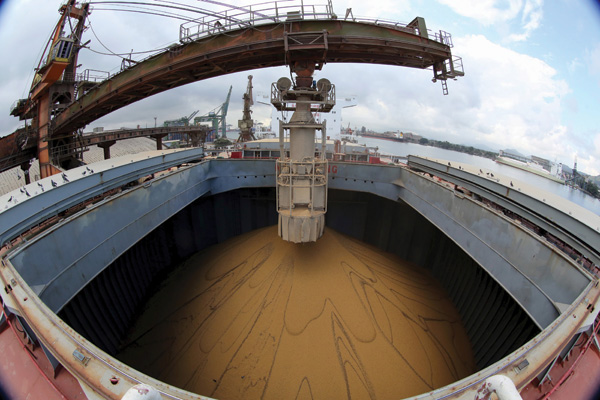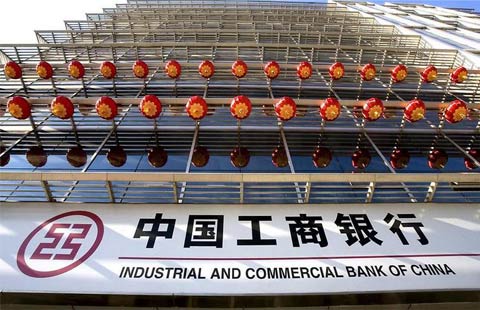China is No 1 for South American exports
Updated: 2015-06-02 04:10
By Paul Welitzkin in New York(China Daily Latin America)
|
||||||||
 |
|
A Chinese ship is loaded with soybeans at Port of Santos on May 19. PAULO WHITAKER / REUTERS |
China has supplanted the United States as the most important destination for South American exports, according to a report.
The 2015 China-Latin America Economic Bulletin, released on May 20 by Boston University's Global Economic Governance Initiative, showed South American exports to China totaled $85.6 billion and exports to the US amounted to $78.9 billion. Latin American exports as a whole to China increased to $112 billion, according to 2013 data (the most recent statistics available) from the United Nations.
"Beginning in 2013, China became the top market for South American product exports. The US was second," said Rebecca Ray, co-author of the bulletin along with colleague Kevin Gallagher of Boston University's Frederick S. Pardee School of Global Studies. "For Mexico, the Caribbean and Central America, the US is still number one."
The emergence of China as a top trading partner for Latin America means the region now has a second potential partner beside the US. "Latin American governments will have another choice when it comes to seeking aid or financing for a project," Ray told China Daily.
"China comes to this region not only as a major market for its exports, but also as a business partner and investor with deep pockets and long-term interests. While it is also a highly asymmetrical relationship, as it has been with the US, it´s on different terms and includes potential investment in major infrastructure projects that many Latin American governments are eager to pursue," said Cynthia Sanborn, director of the research center and a professor of political science at the Universidad del Pacífico in Lima, Peru, in an e-mail.
Sanborn said China's prominence in the region comes as the US has stepped back a bit from Latin America. "The US is preoccupied with other regions of the world, and in a country like Peru, for example, US policy continues to focus on what is widely recognized as a failed policy to fight drug trafficking," she added.
However, Ray believes the US will still remain a major trading partner and ally for Latin America. "The US hasn't given up on Latin America. We are just talking about the addition of another partner," she said.
There is also a difference between what the US and China expect from Latin America in political and foreign policy terms, said Sanborn.
"The Chinese so far are not asking for the kind of political conditions or concessions from these countries that the US has sought in the past," she said.
"The US has a history of maintaining a diplomatic side to its trading relationship," said Ray. "China hasn't shown any interest in seeking political or diplomatic support from Latin America."
Trade between China and Latin America is still heavily focused on the export of commodities to China.
How can the region diversify the trade?
Sanborn said tourism is one place to start: "China is now a major source of tourists coming to this region. And this is another area where a country like Peru has to do more work – we have a few major, world famous destinations – especially Machu Picchu. But to get more tourists to come, and to come back again we need better infrastructure, better tour guides and operators, and much better service."
Ray said improving the infrastructure in the region could also help vary the trade between China and Latin America. "The discussion last week between Chinese Premier Li Keqiang and Brazilian President Dilma Rousseff on a South American transcontinental railway demonstrates one way infrastructure investment can pay off for both sides," she said.
The proposed railway from Brazil to Peru would be the first one to link the Atlantic and Pacific oceans on the continent.
paulwelitzkin@chinadailyusa.com

 Anxious wait for family members of passengers on capsized ship
Anxious wait for family members of passengers on capsized ship
 Key facts in the 12 hours after ship capsizes in Yangtze River
Key facts in the 12 hours after ship capsizes in Yangtze River
 Massive operation launched to rescue ship passengers
Massive operation launched to rescue ship passengers
 Farmers bet on the bull market
Farmers bet on the bull market
 Top 10 largest banks in the world
Top 10 largest banks in the world
 Ten injured in crane accident in Manhattan
Ten injured in crane accident in Manhattan
 Forum trends: Becoming 'a little more Chinese'
Forum trends: Becoming 'a little more Chinese'
 Giraffe survives for five years with zig-zag neck
Giraffe survives for five years with zig-zag neck
Most Viewed
Editor's Picks

|

|

|

|

|

|
Today's Top News
Ship carrying 458 people sinks in Yangtze River
Win-win solution is US should seek in Aisa
Woman behind Silicon Valley sex bias suit appealing verdict
Defense hawk Senator Lindsey Graham launches presidential bid
Chinese soldier
gets UN award
Nation's astronauts eager for foreign missions
China committed to upholding peace, stability in South China Sea
Li's trip a watershed in China-Latin America ties
US Weekly

|

|






